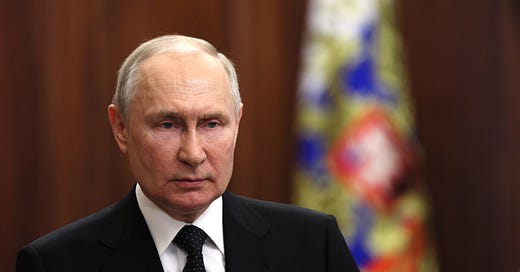Black Sea ceasefire is a potential win for Putin
A ceasefire in the Black Sea gives Russia’s embattled naval forces space to breathe, and allows Putin to continue changing facts on the ground in Kursk and Ukraine.
President Trump is still striving for his next “deal of the century”, and events may be turning in his favour. In the latest chapter of the Russia-Ukraine ceasefire saga, the United States announced a potential breakthrough this afternoon. Following the most recent round of US-brokered negotiations in Saudi Arabia, the White House released two separate statements declaring that Ukraine and Russia have both agreed in principle to implement a maritime ceasefire in the Black Sea.
The statements said that all three parties – Russia, Ukraine, and the United States – “have agreed to ensure safe navigation, eliminate the use of force, and prevent the use of commercial vessels for military purposes in the Black Sea.”
The troika also agreed “to develop measures” for the implementation of an “agreement to ban strikes against energy facilities of Russia and Ukraine”. This referred to commitments made by the Russian president, Vladimir Putin, after a long phone call with his American counterpart last week.
So far, the agreements sound promising. President Volodymyr Zelensky of Ukraine described the deals as a step in the right direction: “It is too early to say that it will work, but these were the right meetings, the right decisions, the right steps.”
Yet no sooner had the ceasefire agreements been proclaimed than doubts and controversies surrounding them began to emerge.
First, the two separate statements represent two separate sets of negotiations – one between the US and Russia, and another between the US and Ukraine. They are a ceasefire only in principle for the simple fact that the two parties required to implement it – Russia and Ukraine – have not yet sat down with one another and consented to the same document. This is not yet the comprehensive ceasefire that the Trump administration has been striving for.
Second, the two warring parties cannot agree on precisely when the ceasefire should come into force. Soon after the White House statements were released, President Zelensky stated that the ceasefire agreements would be “effective immediately”.
Yet the Ukrainian leader’s remarks were contradicted by a statement from the Kremlin. This claimed that the terms of the agreement regarding safe navigation in the Black Sea would only come into force after “the lifting of sanctions” on the state-owned Russian Agricultural Bank, Rosselkhozbank, as well as other “financial institutions involved in international trade of food”. Moscow also called for these institutions to be reconnected to the SWIFT international payments system from which they were ejected in May 2022.
It is clear that Russian demands go beyond the relief measures envisaged by today’s agreement with Washington, which stated simply: “The United States will help restore Russia’s access to the world market for agricultural fertilizer exports, lower maritime insurance costs, and enhance access to ports and payments systems for such transactions.”
By applying more expansive conditions to the agreement, pessimists will argue that Putin is trying to put himself in a win-win scenario: either he succeeds in pressing his demands, and he undermines the sanctions packages agreed between European countries and Washington. Or he fails, but in doing so provides himself with a pretext for not complying with the ceasefire.
On the matter of whether the Kremlin is serious about implementing any deal, Ukraine and her allies will point to the meagre results of last week’s phone call between Trump and Putin. Last Wednesday, the White House announced, to much fanfare, that it had secured Russian agreement to halt all strikes on Ukrainian energy and infrastructure for a period of thirty days. The agreement was supposed to be implemented immediately. Yet within hours of the announcement, Russia launched a large overnight drone and missile strike on Ukraine that hit civilian infrastructure, including an electricity system in Ukraine’s central Dnipropetrovsk region.
Moscow subsequently played on the confusion surrounding whether the 30-day halt referred to attacks on energy and infrastructure (the US understanding) or merely energy infrastructure (the Russian understanding).
Zelensky was quick to argue that this showed his Russian adversaries’ lack of commitment to peace talks.
This gets to the heart of the matter. After more than three years of brutal warfare, any agreement could still run aground because of the fundamental hostility that exists between the Russians and Ukrainians. In an environment in which both parties’ distrust for one another is so great, the Black Sea ceasefire could easily be derailed. It would only take one side to accuse the other of breaking the spirit of the agreement – perhaps by using commercial vessels for military purposes, or by deploying their naval forces in a threatening manner – for the whole arrangement to unravel.
Yet if the deal does go ahead, Putin could be the ultimate winner. Russia’s navy has taken a battering in the Black Sea during the conflict. The Ukrainians have notched up a series of successful strikes against Russian oil facilities and vessels, most notably the Russian navy’s flagship, the Moskva. If Putin can secure a ceasefire here, it would buy some much-needed breathing space for his embattled maritime forces. Crucially, he might also be able to secure some sanctions relief that would further divide the NATO alliance and allow him to acquire the hard currency that he needs to continue propping up Russia’s war economy, which is in danger of overheating.
Ultimately, a ceasefire in the Black Sea would leave the Russian president free to continue changing facts on the ground in Kursk and the Donbas, manoeuvring to put himself in the best possible position for any negotiations on a comprehensive ceasefire and peace deal.




